�
NETWORK FLOWS
Theory, Algorithms,
and Applications
BA VINDRA K. AHUJA
Department of Industrial & Management Engineering
Indian Institute of Technology, Kanpur
THOMAS L. MAGNANT!
Sloan School of Management
Massachusetts Institute of Technology, Cambridge
JAMES B. ORLIN
Sloan School of Management
Massachusetts Institute of Technology, Cambridge
PRENTICE HALL, Upper Saddle River, New Iersey 07458
Library of Congress Cataloging-in-Publication Data
Ahuja, Ravindra K. (date)
Network flows: theory, algorithms, and applications I Ravindra K.
Ahuja, Thomas L. Magnantl. James B. Orlin.
p. cm.
Includes bibliographical references and index.
ISBN 0-13-6J7S49-X
I. Network analysis (Planning) 2. Mathematical optimization.
III. Title.
II. Orlin. James B .. (datel.
I. Magnanti, Thomas L.
TS7.SS.A37 1993
6SS.4'032-dc20
92-26702
CIP
Acquisitions editor: Pete Janzow
Production editor: Merrill Peterson
Cover designer: Design Source
Prepress buyer: Linda Behrens
Manufacturing buyer: David Dickey
Editorial assistant: Phyllis Morgan
The author and publisher of this book have used their best efforts in preparing this book. These effort!
include the development, research, and testing of the theories and programs to determine their
effectiveness. The author and publisher make no warranty of any kind, expressed or implied, with
regard to these programs or the documentation contained in this book. The author and publisher shaH
not be liable in any event for incidental or consequential damages in connection with, or arising out of
the furnishing, performance, or use of these Drograms.
C 1993 by Prentice-Hall, Inc.
Upper Saddle River. New Jeney 074S8
All rights reserved. No part of this book may be
reproduced, in any form or by any means,
without permission in writing from the publisher.
Printed in the United States of America
16 17 18 19
ISBN 0-13-617S49-X
PRENTICE-HALL INTERNATIONAL (UK) LIMITED, London
PRENTICE-HALL OF AUSTRALIA PrY. LIMITED, Sydney
PRENTICE-HALL CANADA INC., Toronto
PRENTICE-HALL HISPANOAMERICANA, S.A., Mexico
PRENTICE-HALL OF INDIA PRIVATE LIMITED, New Delhi
PRENTICE-HALL OF JAPAN, INC., Tokyo
EDITORA PRENTICE-HALL DO BRASIL, LTDA., Rio de Janeiro
�
Ravi dedicates this book to his spiritual master,
Revered Sri Ranaji Saheb.
Tom dedicates this book to his favorite network,
Beverly and Randy.
Jim dedicates this book to Donna,
who inspired him in so many ways.
Collectively, we offer this book as a tribute
to Lester Ford and Ray Fulkerson, whose pioneering research
and seminal text in network flows have been an enduring
inspiration to us and to a generation
of researchers and practitioners.
�
�
CONTENTS
PREFACE, xl
1
INTRODUCTION, 1
1.1
Introduction, 1
Network Flow Problems, 4
1.2
Applications, 9
1.3
Summary, 18
1.4
Reference Notes, 19
Exercises, 20
2 PATHS, TREES, AND CYCLES, 23
2.1
2.2
2.3
2.4
2.5
Introduction, 23
Notation and Definitions, 24
Network Representations, 31
Network Transformations, 38
Summary, 46
Reference Notes, 47
Exercises, 47
3 ALGOlUTHM DESIGN AND ANALYSIS, ~3
3.1
3.2
3.3
3.4
3.5
3.6
Introduction, 53
Complexity Analysis, 56
Developing Polynomial-Time Algorithms, 66
Search Algorithms, 73
Flow Decomposition Algorithms, 79
Summary, 84
Reference Notes, 85
Exercises, 86
4 SHORTEST PA THS: LABEL-SETTING ALGOBITHMS, 93
4.1
4.2
4.3
4.4
4.5
4.6
4.7
4.8
Introduction, 93
Applications, 97
Tree of Shortest Paths, 106
Shortest Path Problems in Acyclic Networks, 107
Dijkstra's Algorithm, 108
Dial's Implementation, 113
Heap Implementations, 115
Radix Heap Implementation, 116
v
�
4.9
Summary, 121
Reference Notes, 122
Exercises, 124
15 SHORTEST PATHS: LABEL-COBBECTING ALGOBITHMS, 133
Introduction, 133
Optimality Conditions, 135
Generic Label-Correcting Algorithms, 136
Special Implementations of the Modified Label-Correcting Algorithm, 141
Detecting Negative Cycles, 143
All-Pairs Shortest Path Problem, 144
5.1
5.2
5.3
5.4
5.5
5.6
5.7 Minimum Cost-to-Time Ratio Cycle Problem, 150
5.8
Summary, 154
Reference Notes, 156
Exercises, 157
8 MAXIMUM FLOWS: BABIC IDEAS, 188
6.1
6.2
6.3
6.4
6.5
6.6
6.7
6.8
Introduction, 166
Applications, 169
Flows and Cuts, 177
Generic Augmenting Path Algorithm, 180
Labeling Algorithm and the Max-Flow Min-Cut Theorem, 184
Combinatorial Implications of the Max-Flow Min-Cut Theorem, 188
Flows with Lower Bounds, 191
Summary, 196
Reference Notes, 197
Exercises, 198
7 MAXIMUM FLOWS: POLYNOMIAL ALGOBITHMB, 207
Introduction, 207
Distance Labels, 209
Capacity Scaling Algorithm, 210
Shortest Augmenting Path Algorithm, 213
Distance Labels and Layered Networks, 221
Generic Preflow-Push Algorithm, 223
FIFO Preflow-Push Algorithm, 231
Highest-Label Preflow-Push Algorithm, 233
Excess Scaling Algorithm, 237
7.1
7.2
7.3
7.4
7.5
7.6
7.7
7.8
7.9
7.10 Summary, 241
Reference Notes, 241
Exercises, 243
8 MAXIMUM FLOWS: ADDITIONAL TOPICS, 2lJO
Introduction, 250
Flows in Unit Capacity Networks, 252
Flows in Bipartite Networks, 255
Flows in Planar Undirected Networks, 260
Dynamic Tree Implementations, 265
8.1
8.2
8.3
8.4
8.5
vi
Contents
�
8.6
8.7
8.8
Network Connectivity, 273
All-Pairs Minimum Value Cut Problem, 277
Summary, 285
Reference Notes, 287
Exercises, 288
9 MINIMUM COST FLOWS: BABIC ALGOBITHMS, 294
Introducti"on, 294
Applications, 298
Optimality Conditions, 306
9.1
9.2
9.3
9.4 Minimum Cost Flow Duality, 310
9.5
9.6
9.7
9.8
9.9
9.10 Relaxation Algorithm, 332
9.11
9.12 Summary, 339
Relating Optimal Flows to Optimal Node Potentials, 315
Cycle-Canceling Algorithm and the Integrality Property, 317
Successive Shortest Path Algorithm, 320
Primal-Dual Algorithm, 324
Out-of-Kilter Algorithm, 326
Sensitivity Analysis, 337
Reference Notes, 341
Exercises, 344
10 MINIMUM COST FLOWS: POLYNOMIAL ALGORITHMS, 8lJ7
Introduction, 357
Capacity Scaling Algorithm, 360
Cost Scaling Algorithm, 362
Double Scaling Algorithm, 373
10.1
10.2
10.3
10.4
10.5 Minimum Mean Cycle-Canceling Algorithm, 376
10.6
10.7
10.8
Repeated Capacity Scaling Algorithm, 382
Enhanced Capacity Scaling Algorithm, 387
Summary, 395
Reference Notes, 396
Exercises, 397
11 MINIMUM COST FLOWS: NETWORK SIMPLEX ALGO.RlTHMS, 402
Introduction, 402
Cycle Free and Spanning Tree Solutions, 405
11.1
11.2
11.3 Maintaining a Spanning Tree Structure, 409
Computing Node Potentials and Flows, 411
11.4
11. 5
Network Simplex Algorithm, 415
Strongly Feasible Spanning Trees, 421
11.6
Network Simplex Algorithm for the Shortest Path Problem, 425
11.7
Network Simplex Algorithm for the Maximum Flow Problem, 430
11.8
11.9
Related Network Simplex Algorithms, 433
11.10 Sensitivity Analysis, 439
11.11 Relationship to Simplex Method, 441
11.12 U nimodularity Property, 447
11.13
Summary, 450
Reference Notes, 451
Exercises, 453
Contents
vii
�
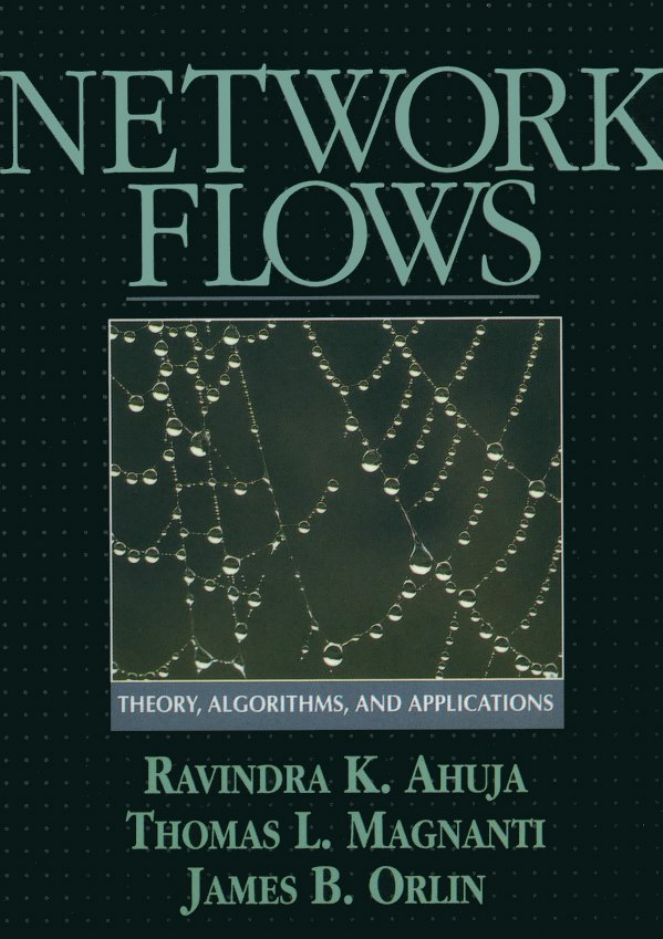
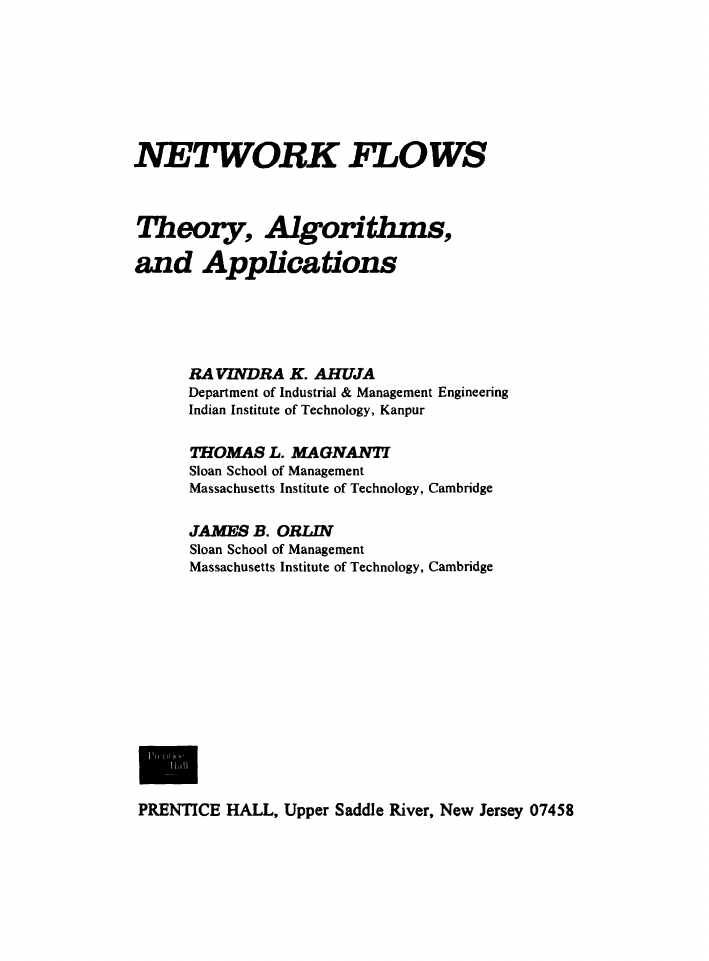
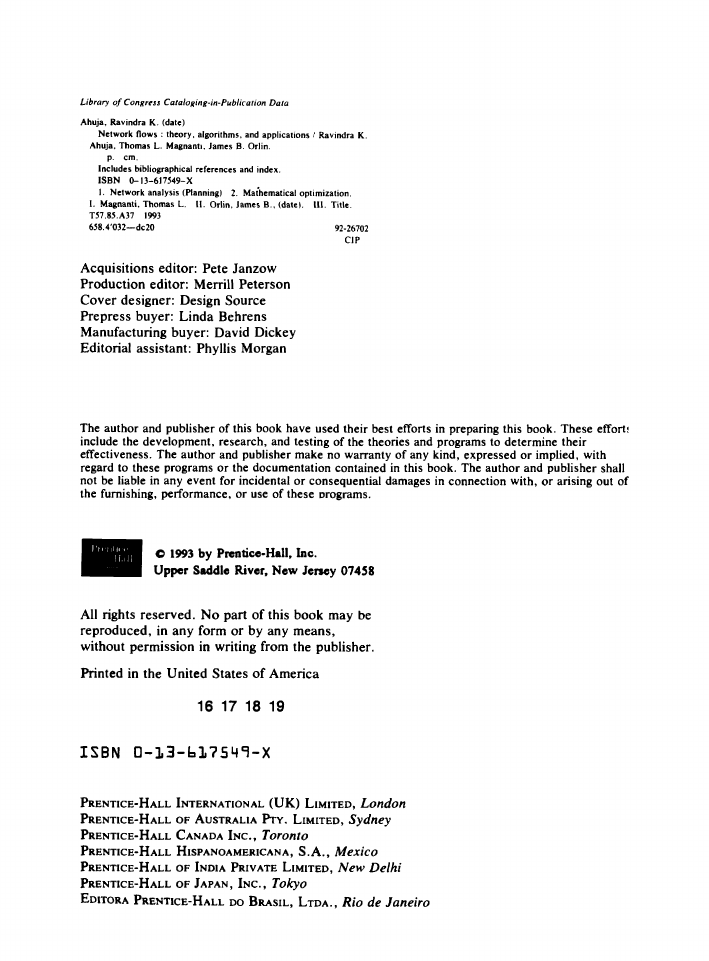


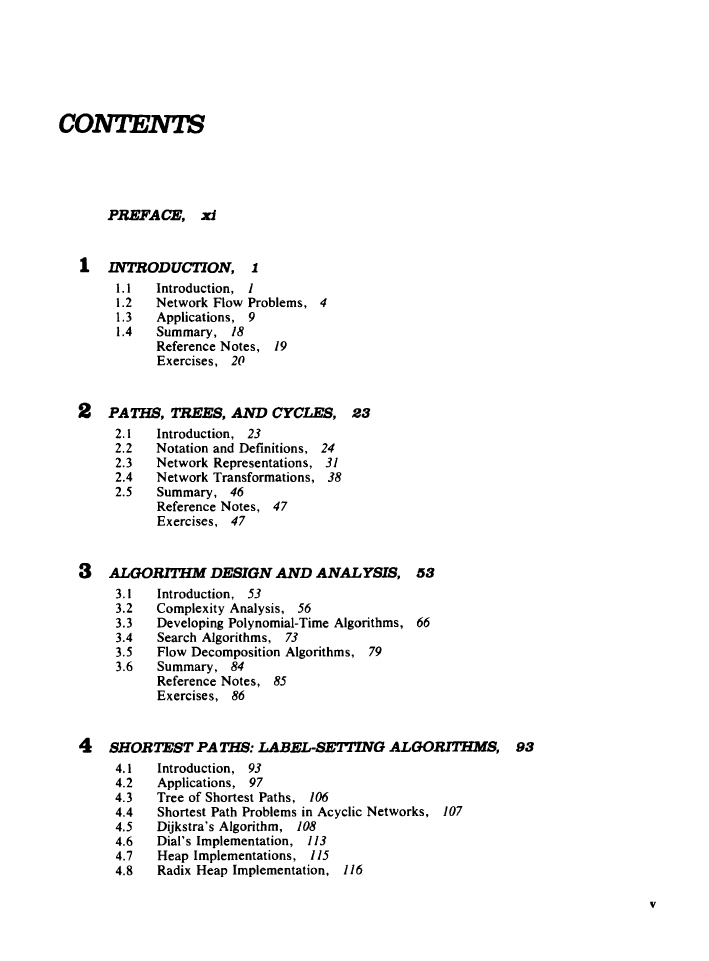

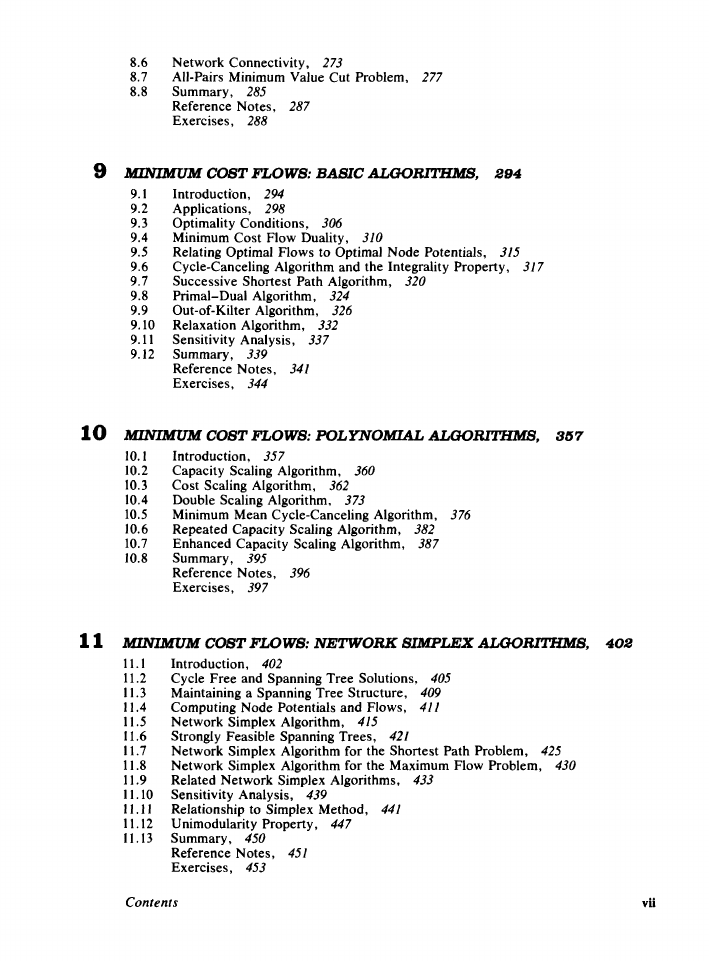








 2023年江西萍乡中考道德与法治真题及答案.doc
2023年江西萍乡中考道德与法治真题及答案.doc 2012年重庆南川中考生物真题及答案.doc
2012年重庆南川中考生物真题及答案.doc 2013年江西师范大学地理学综合及文艺理论基础考研真题.doc
2013年江西师范大学地理学综合及文艺理论基础考研真题.doc 2020年四川甘孜小升初语文真题及答案I卷.doc
2020年四川甘孜小升初语文真题及答案I卷.doc 2020年注册岩土工程师专业基础考试真题及答案.doc
2020年注册岩土工程师专业基础考试真题及答案.doc 2023-2024学年福建省厦门市九年级上学期数学月考试题及答案.doc
2023-2024学年福建省厦门市九年级上学期数学月考试题及答案.doc 2021-2022学年辽宁省沈阳市大东区九年级上学期语文期末试题及答案.doc
2021-2022学年辽宁省沈阳市大东区九年级上学期语文期末试题及答案.doc 2022-2023学年北京东城区初三第一学期物理期末试卷及答案.doc
2022-2023学年北京东城区初三第一学期物理期末试卷及答案.doc 2018上半年江西教师资格初中地理学科知识与教学能力真题及答案.doc
2018上半年江西教师资格初中地理学科知识与教学能力真题及答案.doc 2012年河北国家公务员申论考试真题及答案-省级.doc
2012年河北国家公务员申论考试真题及答案-省级.doc 2020-2021学年江苏省扬州市江都区邵樊片九年级上学期数学第一次质量检测试题及答案.doc
2020-2021学年江苏省扬州市江都区邵樊片九年级上学期数学第一次质量检测试题及答案.doc 2022下半年黑龙江教师资格证中学综合素质真题及答案.doc
2022下半年黑龙江教师资格证中学综合素质真题及答案.doc